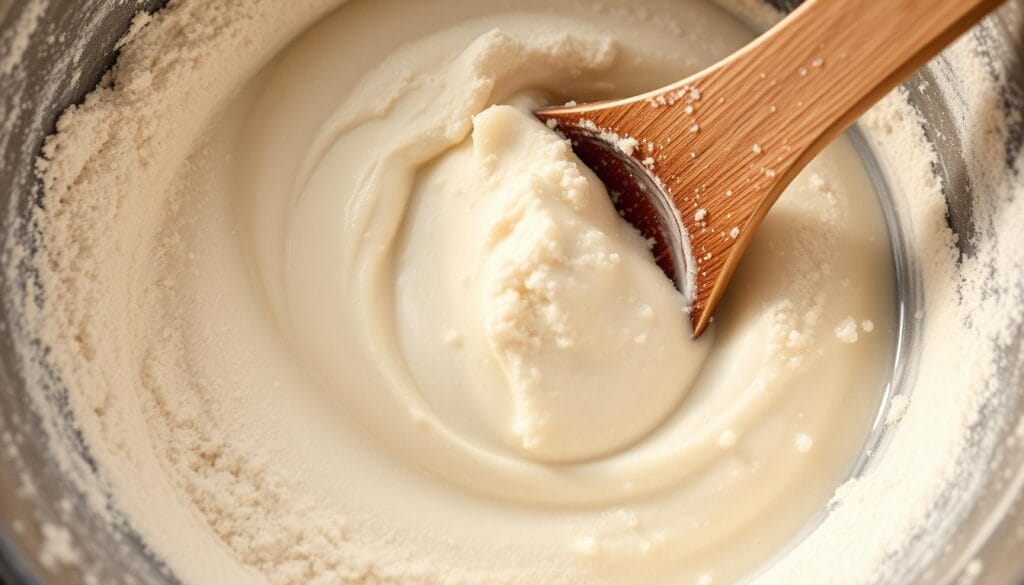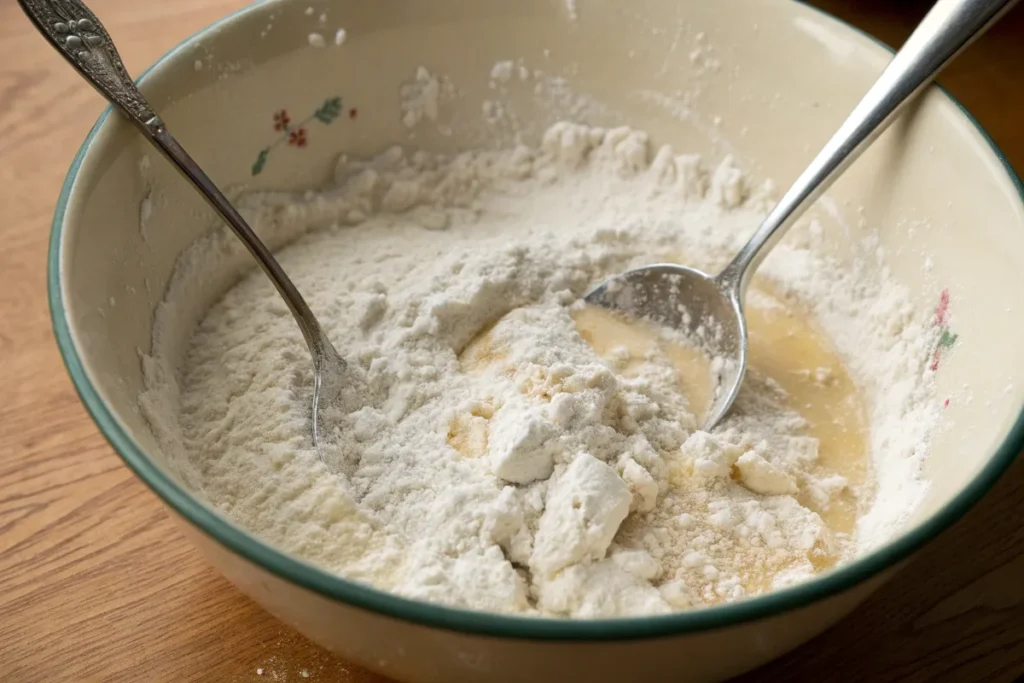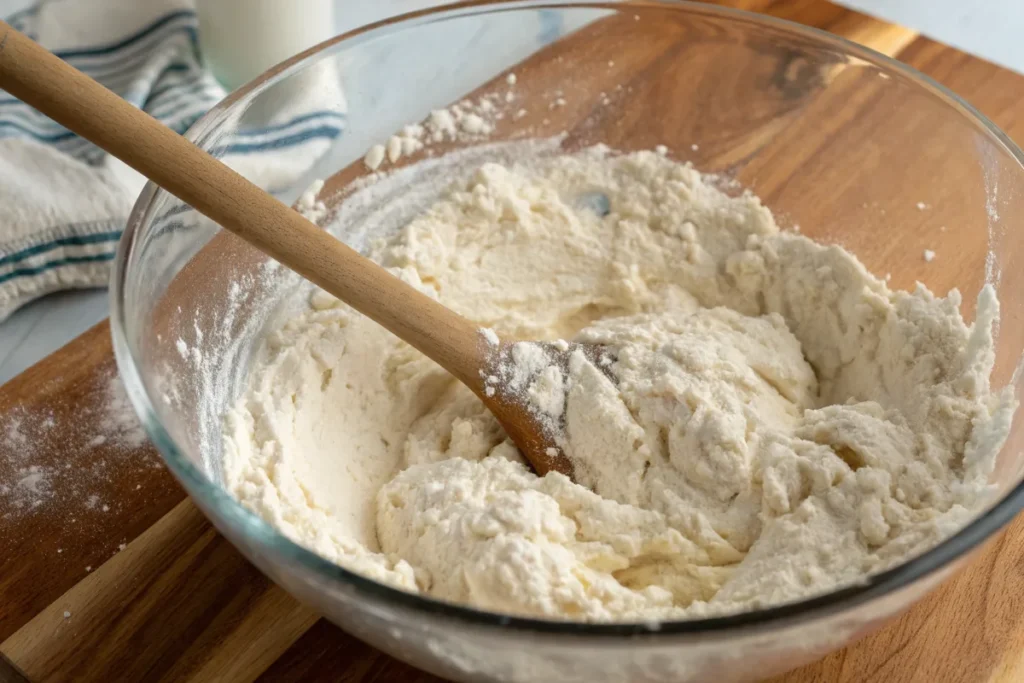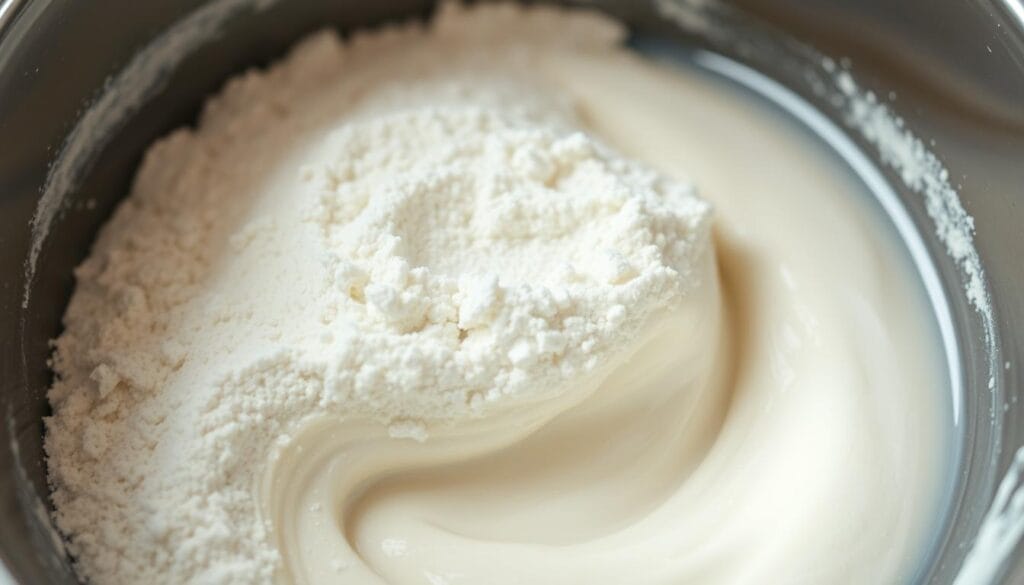
Ever curious about what happens when you mix flour and water? As a home baker, I’ve spent hours in the kitchen. I’ve learned that this simple mix is actually a cool chemistry lesson.
When you mix flour and water, you enter a world of molecular magic. This experiment shows us more than just a simple mix. It’s the start of making bread, pastries, and many other dishes.
Think of flour as a mix of proteins, starches, and minerals. When water is added, something amazing starts. The proteins in flour, like gluten, begin to get stronger. This isn’t just mixing. It’s a complex dance of chemical bonds and physical changes.
Table of Contents
The Science Behind Flour and Water Interaction
Mixing flour and water is more than just combining two ingredients. It’s a complex process that changes them into something new. This change is both physical and chemical, leading to a remarkable transformation.

Understanding Gluten Formation
When flour meets water, something special happens. Gluten forms from a dance between glutenin and gliadin proteins. These proteins stretch and link, making dough elastic and structured.
- Proteins absorb water molecules
- Protein strands begin to link together
- Elastic network forms
Chemical Bonding Process
Hydration is what happens when flour and water mix. Water molecules bond with flour through hydrogen bonds. This breaks down complex carbs and lets proteins interact, forming the base of bread and more.
Starch Behavior in Water
Starch granules in flour change when they meet water. They soak up liquid, swell, and gelatinize. This thickens and stabilizes mixtures, affecting the texture of baked goods.
- Starch granules absorb water
- Granules expand and soften
- Gelatinization creates structural changes
Physical and Chemical Changes in the Mixture

Mixing flour and water starts a fascinating change. The dry flour turns into a sticky, cohesive mass. This shows how mixing flour and water for thickening works.
The first mix triggers many changes:
- Proteins in the flour start to work with water molecules
- Gluten networks begin to form
- Starch granules soak up water and swell
- The texture changes from powdery to sticky and elastic
Mixing flour and water for baking involves complex molecular actions. Gluten proteins like glutenin and gliadin are key in making the dough elastic. As you mix more, the dough gets stretchy and smooth.
| Mixing Stage | Physical Changes | Chemical Reactions |
|---|---|---|
| Initial Contact | Powder becomes wet | Water hydrates flour proteins |
| Extended Mixing | Develops elasticity | Gluten network formation |
| Final Stage | Smooth, cohesive mass | Complete protein hydration |
The change keeps going as temperature and mixing time affect the outcome. Knowing these changes helps both home cooks and professional bakers make perfect doughs for bread, pastries, and more.
What Happens When You Mix Flour and Water?
Mixing flour and water for bread starts a fascinating process. A complex chemical reaction begins, leading to bread creation. This reveals the magic behind one of humanity’s oldest food preparations.

Initial Reaction Stage
When water meets flour, amazing changes happen. The dry flour absorbs moisture, swelling and interacting. This starts gluten development, the protein network that gives bread its structure.
- Water penetrates flour granules
- Protein molecules begin to align
- Initial hydration starts within seconds
Development of Dough Structure
Mixing flour and water further develops the dough’s structure. Gluten proteins stretch, creating an elastic network. This network traps air bubbles, giving bread its texture.
Hydration Process Explained
The hydration process is key when mixing flour and water for baking. Water saturates the flour, breaking down starch granules for better fermentation. Studies show milled flour can absorb up to 10% more water, making dough perfect for bread.
| Flour Characteristic | Water Interaction |
|---|---|
| Protein Content | Determines gluten strength |
| Starch Damage | Increases water absorption |
| Hydration Level | Impacts dough elasticity |
Understanding these interactions helps you make delicious, perfectly textured bread from flour and water.
Creating Basic Bread with Flour and Water
Learning to make bread with flour, water, and salt is key for home bakers. This simple recipe needs just a few ingredients but offers great satisfaction. You’ll see how three basic items can turn into a tasty loaf.
To begin your bread-making journey, collect these essential ingredients:
- 3 cups of all-purpose flour
- 1.5 cups room temperature water
- 1.5 teaspoons of salt
- 0.5 teaspoons instant yeast
The process of making bread involves several key steps. First, mix your dry ingredients. Then, add water slowly to form a shaggy dough. Mix until just combined, avoiding over-mixing.
| Step | Duration | Temperature |
|---|---|---|
| Initial Resting | 12-18 hours | Room temperature |
| Oven Preheating | 30 minutes | 450°F |
| Covered Baking | 30 minutes | 450°F |
| Uncovered Baking | 10-15 minutes | 450°F |
Professional bakers suggest letting the dough rest overnight. This slow fermentation enhances flavors and texture. When baking, use a Dutch oven for a crispy crust and soft inside.
The secret to perfect bread is patience and precise measurements. With practice and attention to detail, your homemade bread will match professional bakery quality.
The Role of Temperature in Flour-Water Mixtures
Temperature is key when mixing flour and water. Knowing how temperature affects their interaction can greatly improve your cooking and baking.
When you mix flour and water, temperature is a major factor. It determines the mixture’s characteristics and outcomes.
Cold Water Effects
Cold water makes the chemical reactions between flour and water slower. In a flour and water experiment, you’ll see:
- Slower gluten development
- Less protein activation
- Reduced enzyme activity
Hot Water Effects
Hot water speeds up the chemical reactions in flour-water mixtures. The experiment shows interesting changes:
- Faster protein breakdown
- Increased starch gelatinization
- More rapid hydration of flour particles
Optimal Mixing Temperature
The best temperature for mixing flour and water varies by your goal. Professional bakers suggest temperatures between 68-77°F (20-25°C) for the best results.
| Temperature Range | Mixing Characteristics |
|---|---|
| 50-59°F (10-15°C) | Slow gluten formation |
| 68-77°F (20-25°C) | Ideal protein activation |
| 86-95°F (30-35°C) | Rapid enzyme activity |
Understanding temperature dynamics lets you control your flour-water mixtures. This way, you can achieve consistent and desired results in your cooking experiments.
Applications in Cooking and Baking
Mixing flour and water opens up a world of cooking possibilities. This simple mix turns basic ingredients into useful tools. It can make your cooking better.
Chefs and home cooks use flour and water in many ways. Mixing flour and water for baking shows interesting techniques. These techniques work in many cuisines and cooking styles.
- Sauce thickening
- Creating batters for frying
- Developing bread and pastry bases
- Making roux for complex sauces
- Preparing binding agents for meat and vegetable dishes
The science behind mixing flour and water is fascinating. It involves how proteins and starches work together. Knowing this helps you make dishes with the right texture.
| Cooking Application | Flour-Water Mixture Technique |
|---|---|
| Sauce Making | Roux or slurry for thickening |
| Bread Baking | Developing gluten structure |
| Frying Batters | Creating crispy, light coating |
Learning about flour and water can really improve your cooking. Try different techniques to get better at these basic skills.
Common Mistakes When Mixing Flour and Water
Baking with flour and water seems easy, but mistakes can ruin your results. Knowing these common errors can help you make better dough and improve your cooking skills.
When you mix flour and water for bread, being precise is key. Beginners often face challenges that can affect their final product.
Incorrect Ratios: The Foundation of Failure
Getting the right flour-to-water ratio is essential. The wrong mix can lead to:
- Dry, crumbly dough
- Overly sticky mixtures
- Weak gluten development
Problematic Mixing Techniques
How you mix ingredients affects dough quality. Common mistakes include:
- Overmixing, which develops tough gluten
- Undermixing, preventing proper ingredient integration
- Using incorrect mixing speeds
Temperature Control Challenges
Temperature is key in mixing flour and water. Errors can include:
| Temperature Issue | Potential Consequences |
|---|---|
| Water Too Cold | Slow gluten development |
| Water Too Hot | Potential protein denaturation |
| Inconsistent Temperature | Uneven dough formation |
Understanding these mistakes can greatly improve your flour and water mixing. This ensures better bread and baked goods every time.
Professional Tips for Perfect Flour-Water Mixtures
Mastering the art of mixing flour and water for baking takes precision and understanding. Professional bakers see it as a blend of science and skill. They know how to create the perfect mix.
Here are some tips from experts on making bread with flour, water, and salt:
- Use a digital scale to measure ingredients precisely
- Ensure water is at room temperature for consistent results
- Mix slowly to avoid lumps and ensure even hydration
- Let the mixture rest to allow flour to fully absorb
Hydration levels are key to your bread’s success. Different flours need different approaches:
| Flour Type | Recommended Hydration | Typical Result |
|---|---|---|
| White Flour | 65-70% | Smooth, elastic dough |
| Whole Wheat Flour | 70-75% | Denser, more robust texture |
| Rye Flour | 75-80% | Sticky, complex flavor |
Temperature is important when mixing flour and water. The best mixing temperature is between 75-78°F (24-26°C). This helps develop gluten and promotes fermentation. Adjust your techniques based on your environment.
Practice and patience are essential for mastering flour-water mixtures. Try different techniques, observe ingredient interactions, and adjust as needed. This will help you improve your baking skills.
Conclusion
Mixing flour and water opens up a world of culinary possibilities. This simple mix can turn basic ingredients into amazing dishes. From bread and pasta to pastries and sauces, the science behind it is fascinating.
Your kitchen experiments with flour and water can lead to amazing discoveries. The protein in flour, like 11.5% in Central Milling Organic Artisan Baker’s Craft, is key. It helps create structure and texture. By mastering temperature and hydration, you’ll make dishes that impress.
Precision is key when working with flour and water. Whether making delicate pasta or rustic bread, knowing the basics is important. It’s not just a technique, but an art that combines science, creativity, and passion.
Now that you know more, start experimenting. Each time you mix, knead, and fold, you get better. Your culinary adventures are endless, limited only by your imagination and willingness to try new things.
